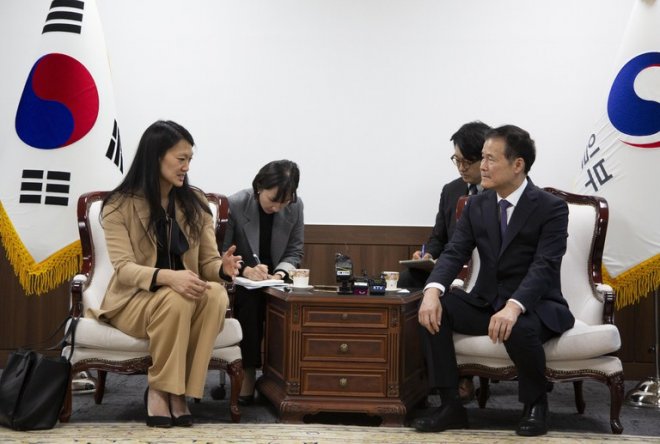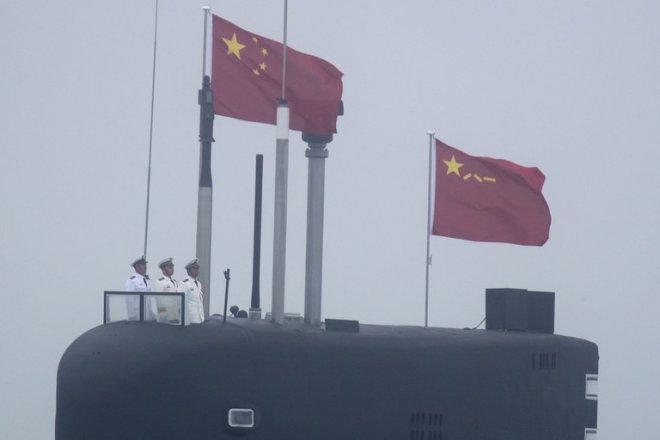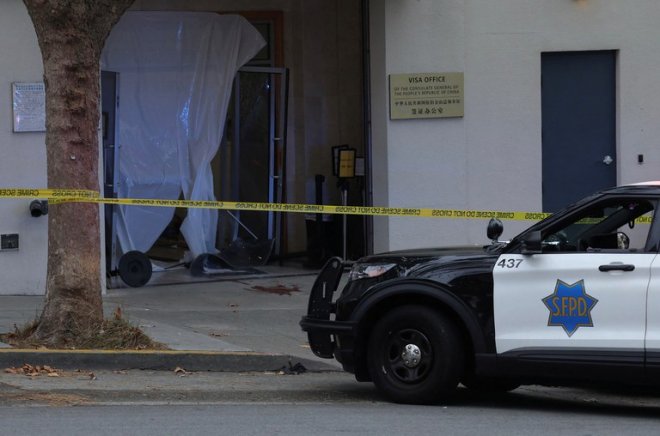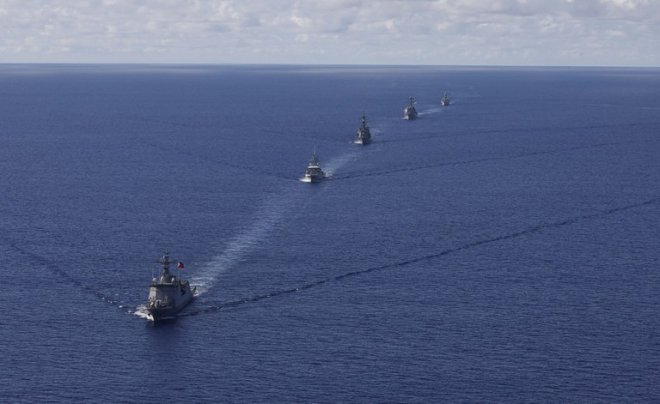US monitors suspected Chinese spy balloon
The U.S. has detected and is monitoring a suspected Chinese high-altitude surveillance balloon that has been hovering over the country for several days, said the Pentagon, just two days before the U.S. Secretary of State’s visit to China.
Canadian defense officials meanwhile said they’re also monitoring a “potential second incident” in Canada and their intelligence agencies are working with American partners to “safeguard Canada’s sensitive information from foreign intelligence threats.”
“The balloon is currently traveling at an altitude well above commercial air traffic, and does not present a military or physical threat to people on the ground,” Air Force Brig. Gen. Pat Ryder told a special briefing at the Pentagon Thursday.
An unnamed senior official present at the briefing said they “have very high confidence that this is a PRC balloon,” referring to China by its official name the People’s Republic of China.
The official also said that the balloon “has limited added value from an intelligence collection perspective,” but the authorities are still taking measures to protect against foreign intelligence collection of sensitive information.
It is believed to be the size of three buses and complete with a technology bay that American officials “wouldn"t characterize it as revolutionary.”
As the balloon was floating over the state of Montana, the Billings airport was shut down on Wednesday and a number of Air Force assets including F-22 fighters were mobilized.
![]() An Air Force police guard stands watch over a nuclear missile silo at Malmstrom Air Force Base in northern Montana, near the Canadian border, Aug. 22, 2005.
An Air Force police guard stands watch over a nuclear missile silo at Malmstrom Air Force Base in northern Montana, near the Canadian border, Aug. 22, 2005.
Credit: Reuters/Adam Tanner
Montana is home to Malmstrom Air Force Base, one of the most sensitive U.S. military installations, equipped with siloed nuclear weapons.
President Biden was “asked for military options” but was advised not to shoot the balloon down over concerns that debris could cause casualties on the ground.
According to the Defense Department, “instances of this activity have been observed over the past several years, including prior to this administration.”
Angry U.S. reaction
Pentagon officials said they have “engaged PRC officials with urgency through multiple channels” about the balloon incident.
“We have communicated to them the seriousness with which we take this issue,” they said.
China said it is looking into reports of the balloon.
"Speculation and hype are not conducive to the solution of the problem until facts are clear,” Foreign Ministry spokesperson Mao Ning said Friday, urging both sides to “handle the matter calmly and prudently."
Meanwhile a Beijing-based government think tank cast doubt over the U.S. allegations.
“Highly doubt the truth of the news! Is there any evidence to confirm that this balloon is from China?” asked the South China Sea Probing Initiative (SCSPI).
“By now, it"s all media relayed news. Is there any direct official report on this?” it questioned.
Liu Ming, founder of MiEntropy Technology, a Chinese intelligence technology company, was quoted by Chinese media as saying that “the probability of flying such balloons from mainland China to the United States is extremely small.”
They are more likely to come “from merchant ships of various countries sailing on the west coast of the United States,” Liu was quoted as saying.
Su Tzu-yun, a military expert from Taiwan’s Institute for National Defense and Strategy Research (INDSR), a government think tank, said in his opinion “the Chinese balloon was released from a ship at sea.”
“Montana is in the northwestern part of the United States and the jet stream at high altitude traveled west to east, bringing the balloon,” Su said.
The news nevertheless was met with angry responses from some U.S. political figures.
“China’s brazen disregard for U.S. sovereignty is a destabilizing action that must be addressed, and President Biden cannot be silent,” House Speaker Kevin McCarthy wrote on Twitter.
McCarthy, who is reportedly planning a visit to Taiwan in April, said he is “requesting a Gang of Eight briefing”, or a national security briefing for eight congressional leaders from the intelligence committees.
Republican Senator Tom Cotton said: “Secretary Blinken should cancel his trip to China. And President Biden must answer why he has not secured U.S. airspace.”
Antony Blinken is expected to visit China on Feb. 5-6 and meet with China"s President Xi Jinping.
Representatives Mike Ghallager and Raja Krishnamoorthi said Beijing’s “recent diplomatic overtures do not represent a substantive change in policy” and that China’s threats are “here at home” and the U.S. must act to counter them.
Relations between the two superpowers have strained in recent years over security concerns, trade, the Taiwan issue and strategic competition.
‘Gray zone tactic’
The suspected Chinese balloon is said to typically operate at 80,000-120,000 feet (24,000-37,000 meters), compared to 33,000 and 42,000 feet (10,000-12,800 meters) for commercial aircraft.
Chinese high-altitude balloons are not a rare phenomenon and have been detected many times in East Asia. They appeared four times in Taiwan’s airspace in February and March last year.
A balloon with a cross-shaped object was spotted flying over the northeastern region of Japan in 2020. At that time, the Japanese Ministry of Defense said that it was closely monitoring the balloon.
The balloon in the latest Montana incident was released “probably not for the purpose of taking pictures because satellites can do that job, but to test U.S. air defense radar and collect various U.S. electronic intelligence,” INDSR’s Su Tzu-yun told RFA.
“It could also be a symbolic ‘gift’ for Blinken before his visit to China,” Su said.
![]() The JY-400 tethered reconnaissance balloon at the 2018 Zhuhai Air Show in China. Credit: Taiwan’s Central News Agency
The JY-400 tethered reconnaissance balloon at the 2018 Zhuhai Air Show in China. Credit: Taiwan’s Central News Agency
Another military analyst said apart from surveillance, the incident is “a political irritant now that civilians are aware of it.”
“I guess we could call this another gray zone tactic,” said Alexandre Neill, adjunct fellow at Hawaii’s Pacific Forum think tank.
Gray zone activities are generally not explicit acts of war but harmful to the security of a nation.
“China is sending them through Japanese, Canadian and U.S. airspace,” “Should these allied countries be tolerating Chinese surveillance balloons transiting national airspace?” Neill asked.
According to Su in Taipei, the U.S. military has yet to shoot the balloon down for counter-intelligence reasons.
“By observing the movements of this balloon, as well as electronic communications of the datalink they can examine the real intention of the People’s Liberation Army,” said the Taiwanese military expert, describing it as “the art of intelligence.”
In recent years, China has been developing new types of balloons and spacecraft.
The Aviation Industry Corporation of China (AVIC) last year registered three special-configuration hot air balloons that the manufacturer said were designed for civilian use but can also be deployed for surveillance.
For their part, U.S. companies have also been making high-altitude military-grade balloons for reconnaissance and communication purposes, especially in areas that lack satellite coverage.
Experts say balloons are cheaper than satellites and have a longer cruising time in the air. They can move slowly and observe specific areas for a long period.
[圖擷取自網路,如有疑問請私訊]
Canadian defense officials meanwhile said they’re also monitoring a “potential second incident” in Canada and their intelligence agencies are working with American partners to “safeguard Canada’s sensitive information from foreign intelligence threats.”
“The balloon is currently traveling at an altitude well above commercial air traffic, and does not present a military or physical threat to people on the ground,” Air Force Brig. Gen. Pat Ryder told a special briefing at the Pentagon Thursday.
An unnamed senior official present at the briefing said they “have very high confidence that this is a PRC balloon,” referring to China by its official name the People’s Republic of China.
The official also said that the balloon “has limited added value from an intelligence collection perspective,” but the authorities are still taking measures to protect against foreign intelligence collection of sensitive information.
It is believed to be the size of three buses and complete with a technology bay that American officials “wouldn"t characterize it as revolutionary.”
As the balloon was floating over the state of Montana, the Billings airport was shut down on Wednesday and a number of Air Force assets including F-22 fighters were mobilized.
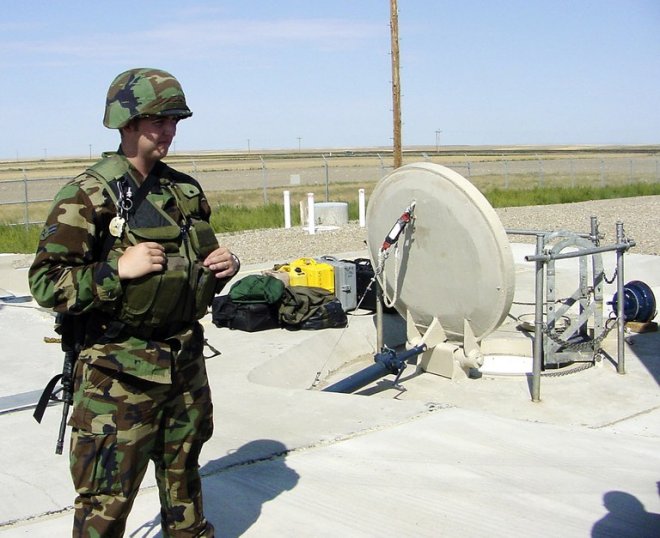 An Air Force police guard stands watch over a nuclear missile silo at Malmstrom Air Force Base in northern Montana, near the Canadian border, Aug. 22, 2005.
An Air Force police guard stands watch over a nuclear missile silo at Malmstrom Air Force Base in northern Montana, near the Canadian border, Aug. 22, 2005. Credit: Reuters/Adam Tanner
Montana is home to Malmstrom Air Force Base, one of the most sensitive U.S. military installations, equipped with siloed nuclear weapons.
President Biden was “asked for military options” but was advised not to shoot the balloon down over concerns that debris could cause casualties on the ground.
According to the Defense Department, “instances of this activity have been observed over the past several years, including prior to this administration.”
Angry U.S. reaction
Pentagon officials said they have “engaged PRC officials with urgency through multiple channels” about the balloon incident.
“We have communicated to them the seriousness with which we take this issue,” they said.
China said it is looking into reports of the balloon.
"Speculation and hype are not conducive to the solution of the problem until facts are clear,” Foreign Ministry spokesperson Mao Ning said Friday, urging both sides to “handle the matter calmly and prudently."
Meanwhile a Beijing-based government think tank cast doubt over the U.S. allegations.
“Highly doubt the truth of the news! Is there any evidence to confirm that this balloon is from China?” asked the South China Sea Probing Initiative (SCSPI).
“By now, it"s all media relayed news. Is there any direct official report on this?” it questioned.
Liu Ming, founder of MiEntropy Technology, a Chinese intelligence technology company, was quoted by Chinese media as saying that “the probability of flying such balloons from mainland China to the United States is extremely small.”
They are more likely to come “from merchant ships of various countries sailing on the west coast of the United States,” Liu was quoted as saying.
Su Tzu-yun, a military expert from Taiwan’s Institute for National Defense and Strategy Research (INDSR), a government think tank, said in his opinion “the Chinese balloon was released from a ship at sea.”
“Montana is in the northwestern part of the United States and the jet stream at high altitude traveled west to east, bringing the balloon,” Su said.
The news nevertheless was met with angry responses from some U.S. political figures.
“China’s brazen disregard for U.S. sovereignty is a destabilizing action that must be addressed, and President Biden cannot be silent,” House Speaker Kevin McCarthy wrote on Twitter.
McCarthy, who is reportedly planning a visit to Taiwan in April, said he is “requesting a Gang of Eight briefing”, or a national security briefing for eight congressional leaders from the intelligence committees.
Republican Senator Tom Cotton said: “Secretary Blinken should cancel his trip to China. And President Biden must answer why he has not secured U.S. airspace.”
Antony Blinken is expected to visit China on Feb. 5-6 and meet with China"s President Xi Jinping.
Representatives Mike Ghallager and Raja Krishnamoorthi said Beijing’s “recent diplomatic overtures do not represent a substantive change in policy” and that China’s threats are “here at home” and the U.S. must act to counter them.
Relations between the two superpowers have strained in recent years over security concerns, trade, the Taiwan issue and strategic competition.
‘Gray zone tactic’
The suspected Chinese balloon is said to typically operate at 80,000-120,000 feet (24,000-37,000 meters), compared to 33,000 and 42,000 feet (10,000-12,800 meters) for commercial aircraft.
Chinese high-altitude balloons are not a rare phenomenon and have been detected many times in East Asia. They appeared four times in Taiwan’s airspace in February and March last year.
A balloon with a cross-shaped object was spotted flying over the northeastern region of Japan in 2020. At that time, the Japanese Ministry of Defense said that it was closely monitoring the balloon.
The balloon in the latest Montana incident was released “probably not for the purpose of taking pictures because satellites can do that job, but to test U.S. air defense radar and collect various U.S. electronic intelligence,” INDSR’s Su Tzu-yun told RFA.
“It could also be a symbolic ‘gift’ for Blinken before his visit to China,” Su said.
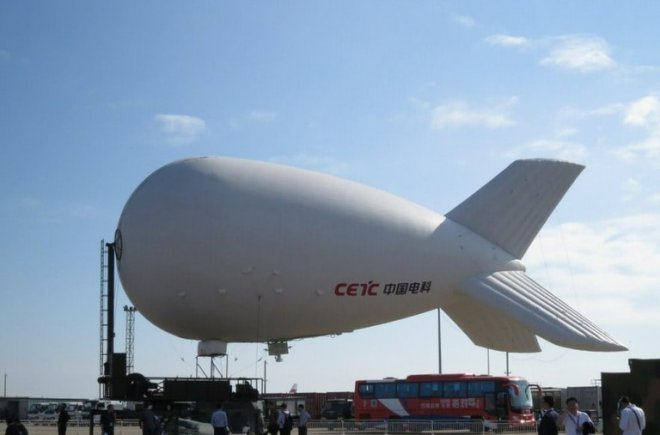 The JY-400 tethered reconnaissance balloon at the 2018 Zhuhai Air Show in China. Credit: Taiwan’s Central News Agency
The JY-400 tethered reconnaissance balloon at the 2018 Zhuhai Air Show in China. Credit: Taiwan’s Central News AgencyAnother military analyst said apart from surveillance, the incident is “a political irritant now that civilians are aware of it.”
“I guess we could call this another gray zone tactic,” said Alexandre Neill, adjunct fellow at Hawaii’s Pacific Forum think tank.
Gray zone activities are generally not explicit acts of war but harmful to the security of a nation.
“China is sending them through Japanese, Canadian and U.S. airspace,” “Should these allied countries be tolerating Chinese surveillance balloons transiting national airspace?” Neill asked.
According to Su in Taipei, the U.S. military has yet to shoot the balloon down for counter-intelligence reasons.
“By observing the movements of this balloon, as well as electronic communications of the datalink they can examine the real intention of the People’s Liberation Army,” said the Taiwanese military expert, describing it as “the art of intelligence.”
In recent years, China has been developing new types of balloons and spacecraft.
The Aviation Industry Corporation of China (AVIC) last year registered three special-configuration hot air balloons that the manufacturer said were designed for civilian use but can also be deployed for surveillance.
For their part, U.S. companies have also been making high-altitude military-grade balloons for reconnaissance and communication purposes, especially in areas that lack satellite coverage.
Experts say balloons are cheaper than satellites and have a longer cruising time in the air. They can move slowly and observe specific areas for a long period.
[圖擷取自網路,如有疑問請私訊]
|
本篇 |
不想錯過? 請追蹤FB專頁! |
| 喜歡這篇嗎?快分享吧! |
相關文章
AsianNewsCast








